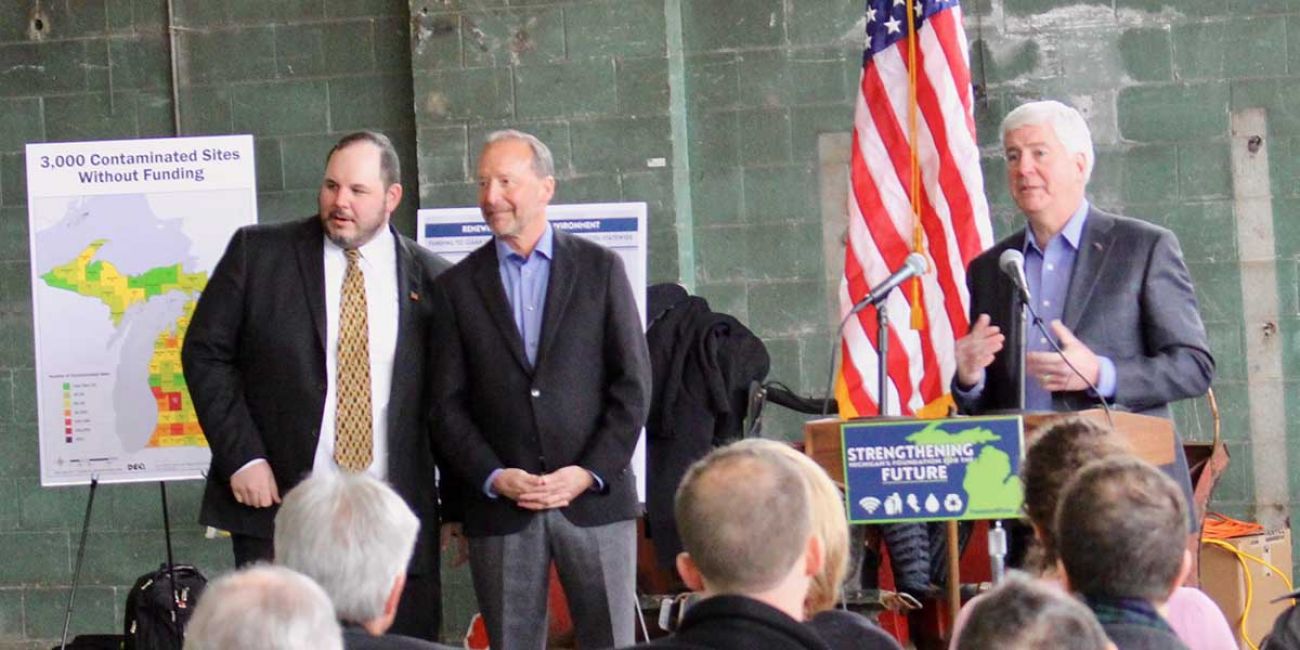Gov. Rick Snyder pitches plan to clean up Michigan’s polluted sites

July 31, 2018: Updated Michigan PFAS map
LANSING — Michigan Gov. Rick Snyder unveiled a proposal Tuesday to replenish funding for cleanups at thousands of polluted sites across Michigan — an effort that would require citizens to chip in a few extra dollars per year.
The Republican wants to increase state fees for dumping at landfills, which he called incredibly low.
Speaking in a century-old manufacturing site that developers plan to transform into an apartment complex, Snyder said Michigan needs a long-term solution to clean and redevelop sites contaminated by from a history of manufacturing, mining and other heavy industries.
Related: Here’s where Michigan governor candidates stand on funding toxic cleanups
Related: Michigan has 7,300 toxic sites. Money for cleanups is almost gone.
The plan, which would require legislative approval, would generate about $79 million through raised fees for solid waste disposal, Snyder said. The money would primarily fund cleanups, but also fund efforts to boost recycling, and improve water quality and state parks.
Michigan’s current fee, 36 cents per ton, makes it one of the world’s most attractive places for out-of-staters to dump their trash, Snyder said. Toronto, for instance, sent its household trash to a landfill in Wayne County for years.
“That’s not a contest I’m aspiring to win.”
Other Great Lakes state charge far higher rates, Snyder said. Under his plan, Michigan’s fee would match Ohio’s fee of $4.75 per ton.
About half of the revenue raised would come from out-of-state and Michigan businesses, with households bearing the rest of the burden.
Since the average Michigan family tosses about a ton of trash per year, it would cost an extra $4.75 each year, Snyder said. That’s about the price of a McDonald’s double quarter pounder with cheese.
“I’ve been very proud of our record reducing taxes,” Snyder said. “But at some point it’s important we pay our fair share, too.”
Snyder is making his pitch as one of the biggest sources for dealing with contamination has mostly dried up: the Clean Michigan Initiative, approved by voters in 1998.
The $675 million bonding program also benefited parks, but most of its funding went toward cleaning and redeveloping polluted sites.
The Michigan Department of Environmental Quality is tracking about 7,300 contaminated sites. Some 3,000 of the polluted sites are likely “orphans,” meaning the original polluter is long gone, leaving taxpayers solely responsible for the cleanup.
MORE COVERAGE: Find PFAS chemical threats to Michigan drinking water near your town
Heidi Grether, the DEQ’s director, said Tuesday her agency had redeveloped more than 1,000 polluted sites through the Clean Michigan Initiative, curbing public health hazards and putting properties back on local tax roles.
She called the effort “vital to our economic strength in the state.”
Snyder called a pay-as-you-go approach more prudent than pushing another bond that would run up state debt.
He unveiled his proposal on a sprawling brick property outside of downtown Lansing. It once hosted a variety of manufacturing companies, including one that built parts for refrigerator trucks in partnership with Ransom E. Olds, the namesake of Oldsmobile.
Brent Forsberg, a Lansing-area real estate developer, is planning to transform the site into an apartment complex, but first must address air quality problems and other hazards — such as asbestos — before constructing 160 units in the building. He said he was applying for state aid to do so.
“Being able to have the programs to reconnect these buildings to our cities is important,” he said.
To make his proposal a reality, Snyder, who is term-limited and in his final year in office, will need buy in from a Republican-controlled legislature that has increasingly gone its own way on taxing and environmental issues.
Here’s how Snyder’s $79 million annual proposal would break down:
- $45 million to clean up 300 sites annually and address emerging contaminants such as PFAS and vapor intrusion
- $9 million to improve solid waste planning for local governments
- $15 million in an effort to triple Michigan’s recycling rate
- $5 million for water quality monitoring
- $5 million to improve state parks
Michigan Environment Watch
Michigan Environment Watch examines how public policy, industry, and other factors interact with the state’s trove of natural resources.
- See full coverage
- Subscribe
- Share tips and questions with Bridge environment reporter Kelly House
Michigan Environment Watch is made possible by generous financial support from:
Our generous Environment Watch underwriters encourage Bridge Michigan readers to also support civic journalism by becoming Bridge members. Please consider joining today.
See what new members are saying about why they donated to Bridge Michigan:
- “In order for this information to be accurate and unbiased it must be underwritten by its readers, not by special interests.” - Larry S.
- “Not many other media sources report on the topics Bridge does.” - Susan B.
- “Your journalism is outstanding and rare these days.” - Mark S.
If you want to ensure the future of nonpartisan, nonprofit Michigan journalism, please become a member today. You, too, will be asked why you donated and maybe we'll feature your quote next time!



